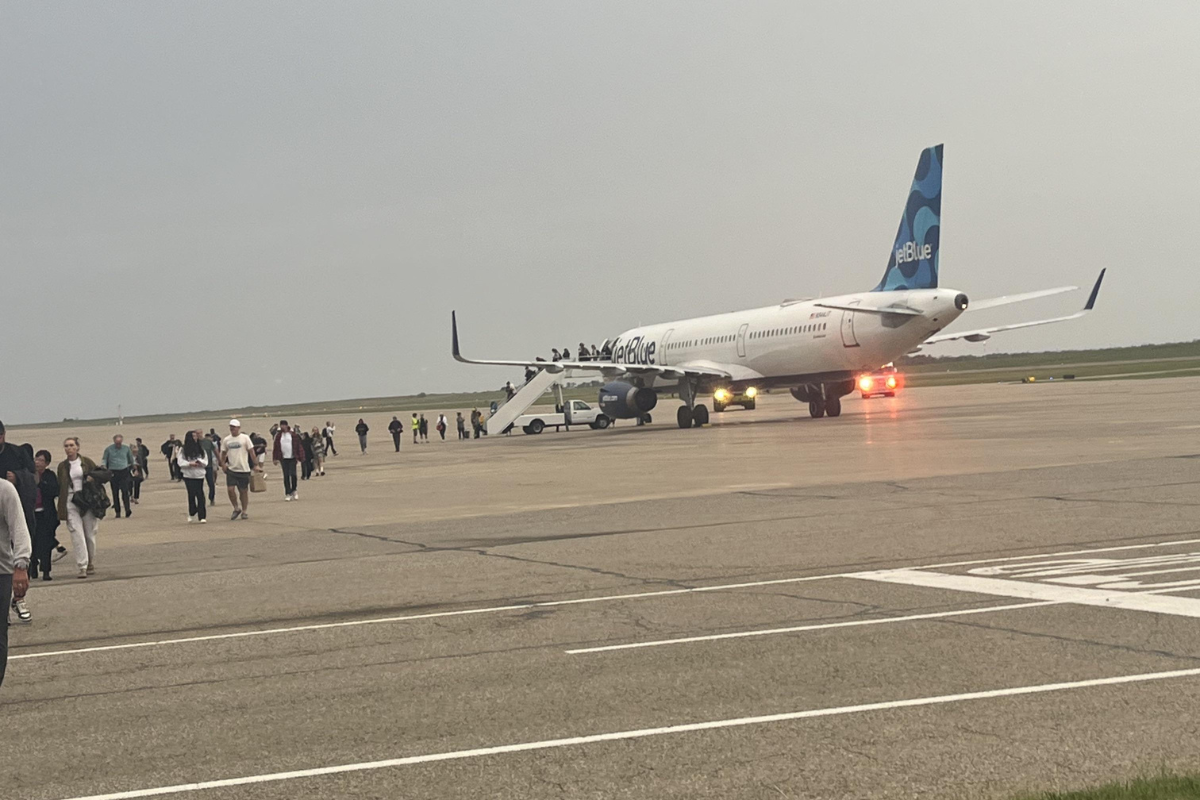
A JetBlue flight from New York to San Diego on Saturday afternoon descended more than 30,000 feet in just ten minutes after the pilots were alerted to a possible fire in the cargo hold.
JetBlue flight 1189 departed New York at around 4:17 pm on September 22 for what should have been a routine five-and-a-half-hour transcontinental flight to the West Coast.
The nine-year-old Airbus A321-200 with as many as 159 passengers onboard was flying over Kansas at around 36,000 feet when passengers noticed that the plane started descending “very, very quickly”.
Flight tracking website Flight Radar 24 shows that the aircraft descended from 36,000 feet to just 4,250 feet in less than ten minutes. The aircraft then made an emergency diversion to Salina Regional Airport in Kansas, where it landed safely and without incident.
One passenger on the flight described the incident on social media platform Reddit, saying he noticed the “flight attendants moving fast and looking scared” as the plane started its rapid descent.
The pilots then came on the public address system to tell the passengers that there had been a smoke indication in the cargo hold which would require them to make an emergency diversion.
Once on the ground, passengers were quickly deplaned via mobile airstairs.
“The airport is so small, they actually got the local school bus drivers to come and bring us from the tarmac to the terminal,” the eyewitness said in his Reddit post.
“Pilot came to talk to us maybe 90 minutes after we landed and said they don’t know if there was any fire or smoke, but since the suppression system was deployed, that plane has to go to Boston to get checked out and can’t carry passengers. They left with the crew,” the post continued.
“The amazing humans at this tiny airport have done their absolute best. Got us snacks and water and ordered pizza for us all (there’s only vending machines here).”
JetBlue managed to arrange for a replacement Airbus A321 to be sent from Boston to Salina on Saturday night where it landed at around midnight. In the end, the passengers arrived in San Diego around eight hours later than planned.
Surprisingly, the aircraft that suffered the cargo smoke alert is already due to return to commercial service on Sunday afternoon.
Cargo fire indications have to be treated very seriously, as there is very little that the crew can do to extinguish a fire if it occurs in the cargo hold. In this case, the pilot informed the passengers that an automatic fire suppression system activated, but there is no other action that the crew can take to fight a fire if this system doesn’t work correctly.
Nearly 44 years ago, Saudi Arabia’s flag carrier Saudia suffered one of the worst aviation disasters in modern history when all 301 passengers and crew died after a cargo hold fire aboard their Lockheed L-1011 Tristar erupted shortly after takeoff from Riyadh en route to Jeddah.
The exact reason why everyone onboard Saudia Flight 163 perished has never been fully established, but a leading theory is that the crew succumbed to toxic smoke and carbon monoxide poisoning before they could start an evacuation.
Cockpit voice recorder evidence highlighted how the flight attendants valiantly tried to suppress the flames with fire extinguishers but their efforts were to no avail.
The pilots of Saudia Flight 163 were criticized for not getting the aircraft on the ground fast enough and then failing to order an immediate evacuation.
Related
Mateusz Maszczynski honed his skills as an international flight attendant at the most prominent airline in the Middle East and has been flying ever since... most recently for a well known European airline. Matt is passionate about the aviation industry and has become an expert in passenger experience and human-centric stories. Always keeping an ear close to the ground, Matt's industry insights, analysis and news coverage is frequently relied upon by some of the biggest names in journalism.








How did the aircraft drop.? You realize at 500 knots , 3000 feet per minute is a normal 3 degree nose down descent rate .